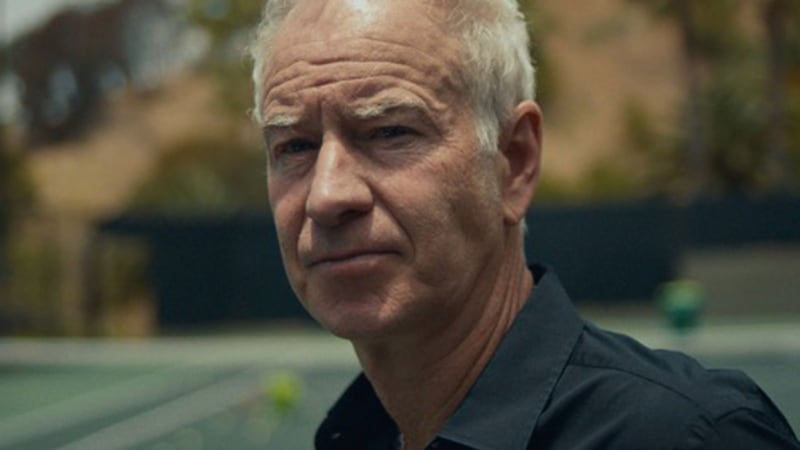“I think every community embraced that shoe: hustlers, drug dealers,” Pharrell Williams says near the beginning of the new documentary Who Is Stan Smith?)" href="https://urldefense.com/v3/__http://www.whoisstansmith.com?__;!!LsXw!QOzytl62L8cxaL_qE4IdJnY2vBiXMbuqAulVDMfzESpAeGiT1D-qzheF0x7Wz6u_XbZGV2Lodhi5MXP8E76Jvj6kxW8$">Who Is Stan Smith?, about the legendary tennis star whose Adidas sneaker bearing his name (and face) became a cultural touchstone across three generations and counting. “If we’re gonna be real, we’re gonna be real.”
As a kid growing up in the late-1970s, Stan Smith’s were the shoe to have. Stylish, cool and, best of all, affordable, they’d quickly grown in popularity far beyond anything Adidas had envisioned in the early-’70s, when they signed Smith, who along with his friend Arthur Ashe dominated professional tennis at the time, to a deal for a branded shoe.
This was long before the era of Air Jordans, of course, when Adidas, Nike and Puma were duking it out for preeminence in the newly burgeoning athletic wear market. And while Nike and Puma had an undeniable cool factor on both the playing field and school playground, it was Stan Smith’s that would explode in popular culture.

“Hip hop appears,” Darryl McDaniels‚ DMC of Run-DMC, recalls in the film. “I don’t really remember seeing Stan Smith’s worn by rappers until the Beastie Boys came along and did the Def Jam tour supporting Run-DMC. We toured the world with the Beasties. These guys were on our Together Forever tour. Me, Run and Jay, we got on our Superstars, and looked down at what the Beasties had on and they rocking the Stans. Here’s these white Jewish kids, who are a punk rock group that live in Manhattan, who love the music of hip hop coming out the Bronx, who get to hook up with the culture representing something that we all have in common.”
The early relationship between Adidas and hip hop culture hit its apex during the Madison Square Garden stop of 1987s Together Forever tour. During Run-DMC’s ode to their footwear of choice, DMC encouraged the crowd to ditch their shoes and hold up their Adidas.
“18,000 people held their Adidas up,” DMC recalls. (It’s true. I should know. I was one of them.)
“It happened organically, it really did,” Smith tells The Daily Beast decades later, still seemingly shocked by the lasting fame of the shoe bearing his name. “It was a performance shoe. We were wearing it to play tennis. And then guys would be wearing it, and girls would be wearing it, off the court. And then you got the hip hop culture, you got the preppy ones, and I don’t know exactly why it has lasted and resonated.”
As Smith’s longtime agent, Donald Dell, recounts in the film, he got together with Horst Dassler, the head of Adidas at the time, and started hammering out the details of what a Stan Smith shoe would look like. “They agreed to put his photograph on the tongue, so every time you laced it up, you saw Stan’s picture,” he recalls. “And that was a big deal.”
Eventually, given the popularity of the shoe amongst the likes of the Beasties, the also-affordable Superstars were born, and both permeated everything from mall culture to MTV to hip hop to the streets.

“I think the Adidas people, over a period of time, came to realize this was a unique icon,” Dell says later in the film. “Not necessarily the greatest player that ever played, but one of the really good people. One day, the Adidas team says, ‘We’d like a lifetime deal.’ And I said, ‘A lifetime deal? Forever?’”
In 2024, with Stan Smith’s still one of Adidas’ best-sellers—and still bearing Smith’s name and image—it’s been 50 years since Smith was a star of the tennis court.
“Who the hell is Stan Smith?” DMC asks at the beginning of the film, in which Emmy-winning director Danny Lee, known for his 30 for 30 documentary and Hulu’s Defining Moments, fills us in on Smith’s astonishing life.
Executive produced by, among others, LeBron James, the film tells the story of a groundbreaking athlete who went from being one of the world’s greatest tennis stars to a leading civil rights and AIDS activist, blazing a trail along the way with his namesake Adidas sneakers—the iconic shoe that has become a fashion statement for hip hop musicians and celebrities for more than 50 years.
“There’s a cleanness and elegance to them in which a subculture can adopt it and almost feel the energy that’s imbued in it,” Lee, who’s clearly thought about why the Stan Smith shoe has taken on a life of its own, tells me ahead of the film’s release. “In England, for instance, there were some disenfranchised kids who were lower income, living on council estates, and they’re rocking the Adidas, and that makes them feel better. So, I think that in the history of fashion and footwear, where a subculture will adopt it and make it their own, while Stan’s career was somewhat in its sunset years in the late ’70s, you saw this shoe take off at a time when streetwear wasn’t so abundant as the way it is now. Back then, it was very limited, so you had to look for things to adopt and make your own.”
The emotional and poignant journey of the film, which charts the extraordinary life of tennis hall of famer, sneaker icon and humanitarian Smith, began its U.S. run in Los Angeles on May 3rd, and opens in New York City on May 10th, eventually adding 50 more markets throughout the month of May.
More than the namesake of one of the most iconic sneakers, Smith has lived a champion’s life, both on and off the tennis court. From his rise as a collegiate superstar as part of the then-all important Davis Cup team, to becoming world number one at Wimbledon, Smith blazed new paths for athletes, as a crucial member of the group that unionized professional tennis and, later, as both a fashion icon and humanitarian. Using intimate first-person accounts and vibrant archival materials, Lee paints a picture of the long journey from a kid who started out playing on public courts to the man behind the shoe that became a movement.
“I think at the heart of the film, what we’re doing is unraveling and peeling back the layers of this iconic namesake sneaker,” Lee explains. “I grew up in LA, in subcultures like skateboarding, graffiti, hip hop. And I remember in high school, in the ’90s, everyone was like, ‘Yo, that guy’s got a Stan Smith!’ It was always this prestige thing. There was something about it. But it was attainable. You just knew that it meant something. So, I had always known the name, but again, when I was approached to direct the film, I knew that there was an incredible story behind it, but I didn’t know to what depths. So, when we got into the process, the thesis became clear: let’s unpack the mystery and mythology behind this name that you know of, but you probably don’t know the story, even if you’re a sports fanatic or sneakers fanatic.”
So, while Who Is Stan Smith? highlights Smith’s tennis accomplishments and, obviously, the fascinating history of the shoe that bears his name and likeness, it’s perhaps Smith’s humanitarian feats off the tennis court, from his relationship with Arthur Ashe, which heavily inspired his anti-racist and AIDS activism, and his relationship with Black tennis player, Mark Mathabane, whom Smith helped escape from apartheid-era South Africa. (“I got to meet Mark down in South Africa, and he was looking to get some help to go to the US, so my wife and I decided to help him,” Smith says with no hint of how remarkable what he did was during Apartheid-era South Africa.)
As for how a middle class kid from small town California became so altruistic, Smith is typically humble in his view.
“I didn’t have a sense of the wider world as a kid,” he tells The Daily Beast. “But I went to USC, and that obviously broadened my horizons a little bit. Then I made the Davis Cup team in ’68, and started traveling and playing against athletes from outside the United States, and also observing what was going on. And of course, what was really going on in ’68, it was pretty amazing. Not only had tennis just become open, so the tennis tide was really changing dramatically, but the rest of the world was changing dramatically at the time. The Vietnam War, civil rights, Kennedy being shot; these things are taking place. So, that was out of school, but really learning what the world was like at that time.”
Smith’s friendship with Arthur Ashe, the understated, Black tennis superstar, who grew into a powerful activist over the course of his career, and most especially after contracting AIDS through a blood transfusion during bypass surgery in the early-’80s, was hugely important, Smith says.
“Seeing what Arthur was going through was a big part of it,” he explains. “Traveling the U.S., and realizing we’re all the same. So, why should he not be able to go into the clubhouse? What was so different? I think all the things we experienced as teammates made an impact on my psyche and the way I thought about things, the way I wanted to lead my life.”
And the shoe, which I joke will no doubt outlive its now-80-year-old namesake, what does Smith think is the secret of its success?
“People always ask me the question, ‘Why?’ And I never know the answer,” Smith says. “But I guess it’s that the simple things sometimes are more attractive than having too many bells and whistles. So, I think the shoe has endured because it’s simple and it’s comfortable, it goes with everything, and hopefully it means something to people when they wear it.”
It’s a hell of a story, of an understated champion whose legacy off the court has already long outlived his playing career and will no doubt long outlive the man himself.
“That’s the real gangster part of this entire story on Stan Smith,” sports journalist Cari Champion says almost wistfully, in the film. “He has his face on a sneaker. Even Jordan doesn’t have his face on a sneaker.”






